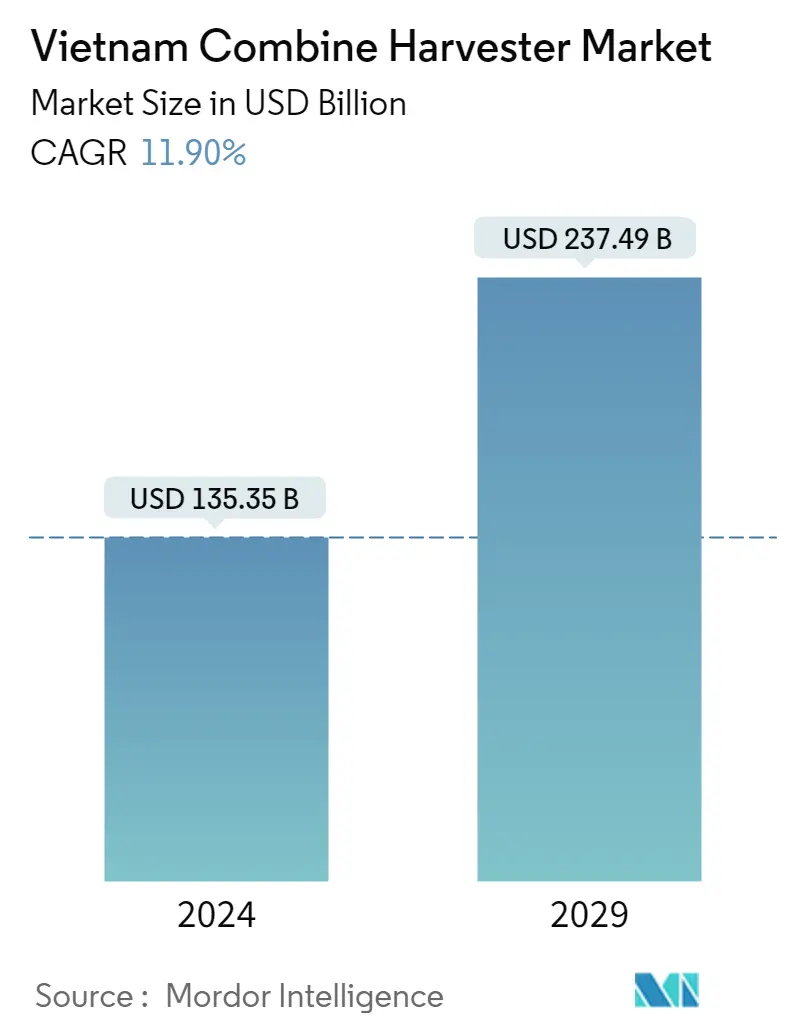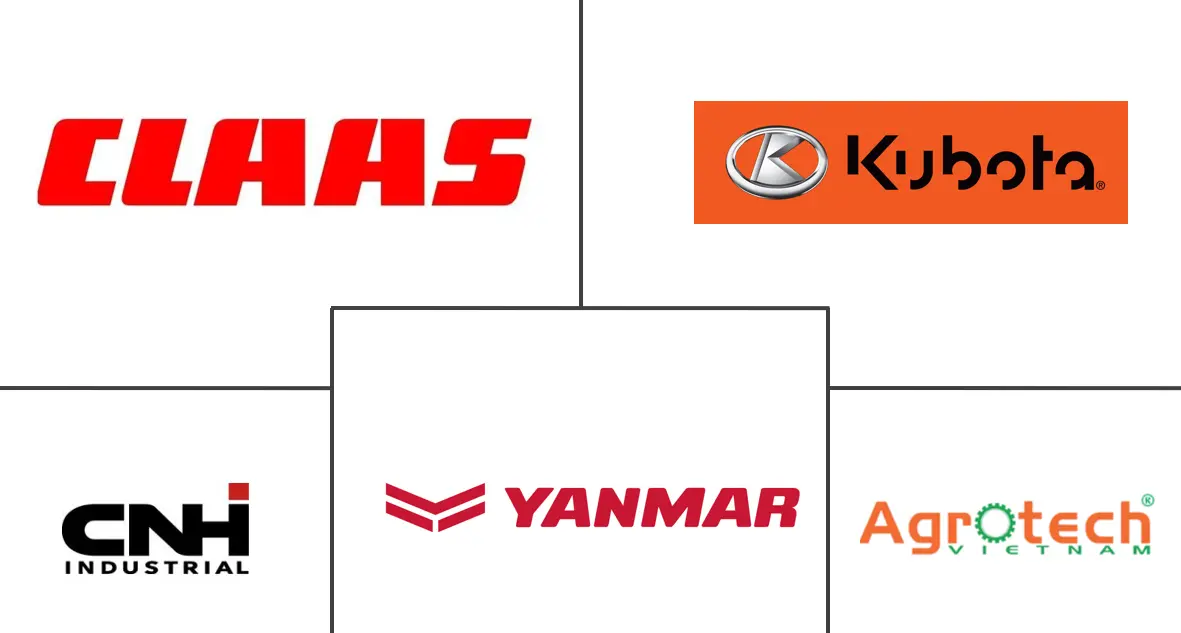Market Size of Vietnam Combine Harvester Industry

| Study Period | 2019 - 2029 |
| Base Year For Estimation | 2023 |
| Market Size (2024) | USD 135.35 Billion |
| Market Size (2029) | USD 237.49 Billion |
| CAGR (2024 - 2029) | 11.90 % |
| Market Concentration | High |
Major Players
*Disclaimer: Major Players sorted in no particular order |
Vietnam Combine Harvester Market Analysis
The Vietnam Combine Harvester Market size is estimated at USD 135.35 billion in 2024, and is expected to reach USD 237.49 billion by 2029, growing at a CAGR of 11.90% during the forecast period (2024-2029).
The overall population of combine harvesters in Vietnam was 751 units during 2018. Around 90% of the combine harvesters sold in Vietnam are imported, with only 10% being domestically produced. Although the combine harvesters produced domestically have improved to a large extent, most farmers still prefer imported combine harvesters. The main reason for this is the high quality and durability of the imported machines. The major factor that is expected to augment the demand for combine harvesters is growth in the urban population and industrialization, which has led to a shortage in farm labor, thus pushing the farmers to employ machinery for harvesting.
Vietnam Combine Harvester Industry Segmentation
A combine harvester is a piece of essential equipment for effective harvesting of grains and other crops. Vietnamese farmers have warmed up to using combine harvesters over the traditional practice of manual harvesting of grains. The three types of combine harvesters used by farmers in Vietnam are Tractor-on-Top (TOT) combine harvesters, Wheel-Type Combine Harvesters and Track-Type Combine Harvesters.
| Type | |
| Tractor-on-Top (TOT) Combine Harvesters | |
| Wheeled-Type Combine Harvesters | |
| Track-Type Combine Harvesters |
Vietnam Combine Harvester Market Size Summary
The Vietnam combine harvester market is poised for significant growth, driven by urbanization and industrialization, which have created a labor shortage in agriculture. Despite the availability of domestically produced combine harvesters, the majority of farmers prefer imported machines due to their superior quality and durability. This preference is fueled by the declining agricultural workforce, as more individuals opt for industrial jobs over farming, leading to a reliance on machinery to maintain productivity. The Mekong River Delta stands out as the largest region for combine harvesters in Vietnam, with major companies like Kubota, Yanmar, and VEAM dominating the market. These companies offer custom hiring facilities to accommodate the high costs of combine harvesters, making them accessible to small-scale farmers through government leasing programs.
The market landscape is characterized by a significant import dependency, with around ninety percent of combine harvesters being imported. This trend underscores the challenges faced by local manufacturers in meeting the quality expectations of Vietnamese farmers. The competition in the agricultural sector has intensified, resulting in lower crop prices and insufficient returns on investment for farmers, further exacerbating the labor shortage issue. As a result, the adoption of combine harvesters is seen as a viable solution to enhance efficiency and reduce the time required for harvesting. The presence of large average land holdings in the Mekong Delta, coupled with the predominance of small-scale farming, highlights the need for adaptable and efficient agricultural machinery to support the region's agricultural productivity.
Vietnam Combine Harvester Market Size - Table of Contents
-
1. MARKET DYNAMICS
-
1.1 Market Overview
-
1.2 Market Drivers
-
1.3 Market Restraints
-
1.4 Porter Five Forces Analysis
-
1.4.1 Bargaining Power of Suppliers
-
1.4.2 Bargaining Power of Buyers
-
1.4.3 Threat of New Entrants
-
1.4.4 Threat of Substitutes
-
1.4.5 Intensity of Competitive Rivalry
-
-
-
2. MARKET SEGMENTATION
-
2.1 Type
-
2.1.1 Tractor-on-Top (TOT) Combine Harvesters
-
2.1.2 Wheeled-Type Combine Harvesters
-
2.1.3 Track-Type Combine Harvesters
-
-
Vietnam Combine Harvester Market Size FAQs
How big is the Vietnam Combine Harvester Market?
The Vietnam Combine Harvester Market size is expected to reach USD 135.35 billion in 2024 and grow at a CAGR of 11.90% to reach USD 237.49 billion by 2029.
What is the current Vietnam Combine Harvester Market size?
In 2024, the Vietnam Combine Harvester Market size is expected to reach USD 135.35 billion.

